Mar. 6—FAIRMONT — The first step toward plugging the sinkhole on the Woman’s Club of Fairmont lawn began on Tuesday.
The West Virginia Department of Environmental Protection began drilling holes and taking core samples around the sinkhole, which will help their engineers figure out their plan of attack toward sealing the hole.
“They have come to our rescue,” said Marcella Yaremchuk, the club member who’s been overseeing most of the work on the club’s behalf. “They know what situation we’re in and didn’t know where to turn.”
DEP supervisors on-site declined to comment directly, due to a policy directing all media requests to Spokesman Terry Fletcher at the DEP’s Charleston offices. Fletcher was reached for authorization to allow the DEP officials to speak, but did not answer the phone in time or return a phone call by press time.
However, Yaremchuk volunteered to act as a go-between, acting as a relay for questions and answers. Despite being hamstrung by department policy, the DEP supervisors and workers were kind, and open to questions from a private citizen. They provided valuable, in-depth and necessary information to Yaremchuk, who in turn relayed it to the Times West Virginian.
This absolutely necessary process took place Tuesday outside next to the Woman’s Club by the sinkhole.
The DEP will drill eight holes on the lawn of the Woman’s Club, taking core samples from each one. Part of it will be to confirm a mine that lies underneath the club. This is important to do, because if the issue isn’t caused by a mine collapse, state funds can’t be used to seal the sinkhole. However, Yaremchuk said the agency was able to confirm a mine did lay underneath after the first core sample.
Second, drilling the holes allows the DEP to explore what’s under the ground, so they don’t have to guess when they come up with their plan to seal the hole. Engineers are following a map of the mine, and the core samples and location of the holes will help the engineers plug any holes in their knowledge of the sinkhole’s surroundings.
Water from the river lubricated the drill, it was pumped directly to the site. The core samples in each hole are done in 5 foot increments, and drilled out until they reach coal. Roughly 60 feet of sandstone lay between the surface and coal. After the core samples were dug out, workers placed them in wooden sample boxes. The sandstone was brittle, easily cleaving into smaller chunks despite a worker’s best attempts to be careful.
Green and pink flags also marked areas DEP workers had to avoid in order to prevent hitting existing sewer lines and other underground infrastructure.
The work should last into next week, assuming the weather remains good. Rain would put a pause on the work, although snow presents no challenge depending on the amount.
The drill the DEP brought was loud.
Yaremchuk recalled one of the neighbors next to the club joking they would leave this week to get away from the noise. However, at least one resident wasn’t perturbed by the work.
Macy Clutter, a new resident to Fairmont, said the noise didn’t bother her. She was unaware of the sinkhole problem the club has had in the past or of the mines which lay under the town. She works at one of the local businesses. Her attitude toward a potential sinkhole forming near her was more or less pragmatic.
“I feel like if it’s something that happens, it happens,” she said. “If it happens, it happens and then take care of it.”
Reach Esteban at efernandez@timeswv.com
Signup bonus from





